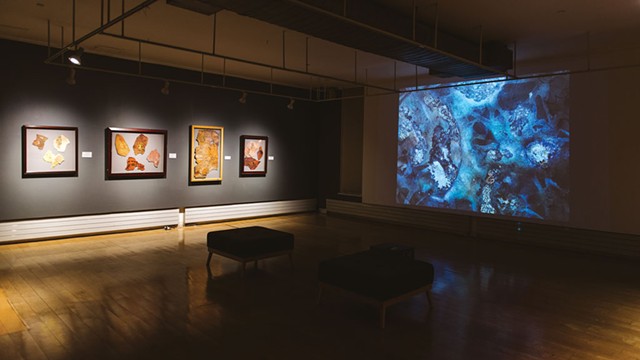
- Courtesy Of Sam Simon
- "Falling Into Language: A Travelogue" at BCA Center
The soundtrack may be the first thing visitors notice about "Falling Into Language: A Travelogue." That's the title of conceptual artist Kaylynn Sullivan TwoTrees' immersive installation of video and framed two-dimensional artworks in a second-floor gallery at Burlington's BCA Center.
Accompanying an 18-minute video that TwoTrees created using her own mixed-paper works, the track begins with a sonorous hum recalling the moment the monolith appears in the film 2001: A Space Odyssey. The sound grows ever more complex, gaining layers of whispered syllables, breaths and sung notes until it is almost mesmerizing.
That is the artist's first cue to visitors to let go of the need to understand or impose meaning on her installation. TwoTrees is interested in the idea of a time outside language — a time of universal heritage before people were fragmented and divided by tongues. She uses vocables — "words" composed of sounds without regard to meaning — as a vehicle. While it's unclear who is "falling into language" in this exhibition, the journey appears to be a shared one, open to all comers.
Evidence of that journey covers the room's other walls. Seven framed works contain torn pieces of paintings made from textured paper, collage and acrylic ink that resemble those featured in the video. Like archaeological traces, these fragments are labeled as if in an explorer's journal: "Map fragment with possible legend — Ancestor journey 7CXX.03" or "Unknown script with pictograph (Apis mellifera)" or "Navigational pattern fragment — Supercluster VC 1794."
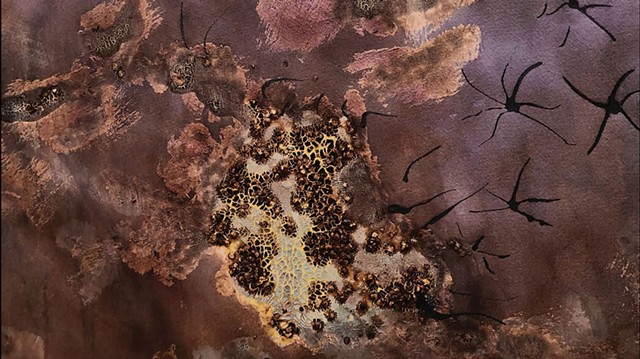
- Courtesy Of Sam Simon
- Video still from "Falling Into Language: A Travelogue"
As a whole, this mythological travelogue appears to tell a story. In the video, the camera slowly pans over and zooms in on TwoTrees' works. The Ken Burns-like close-ups reveal various textures and marks — crackled burns, craterlike ink spills — but the view never widens enough to show the works' edges. As a result, the images resemble a video journey across the topography of an alien planet or an uncharted corner of the universe.
The torn fragments on the walls, by contrast, are like the detritus of those journeys. Fixed and labeled like specimens, they seem to be an attempt to impose meaning on remnants through language.
During a phone call, TwoTrees, who lives in Hinesburg, explained one impetus for her project.
"I'm in my seventh decade, and there is something about knowing you have less time that made me want to leave something in the world that was about ancestral lineage before separation," she said. "People say we're made of stardust — lots of cultures do, and one of my ancestral cultures is one of those." (TwoTrees is of Lakota, Black and white European ancestry.)
"I wanted to take that literally," she continued. "If we're made of stardust, what does it mean to link to our cosmic destiny? To let go of our languages, our cultures, our separation? What does it mean when we use sound to reconnect us to that moment before language?"
TwoTrees said she began the project in 2017 and made at least 70 mixed-paper paintings over three years. For the video — made over the course of six months in India with the help of two Bollywood specialists — she filmed the works whole, then tore them up to create the framed fragments.
"I meant [the paintings] to be a musical score. They were meant to be sung," she said.
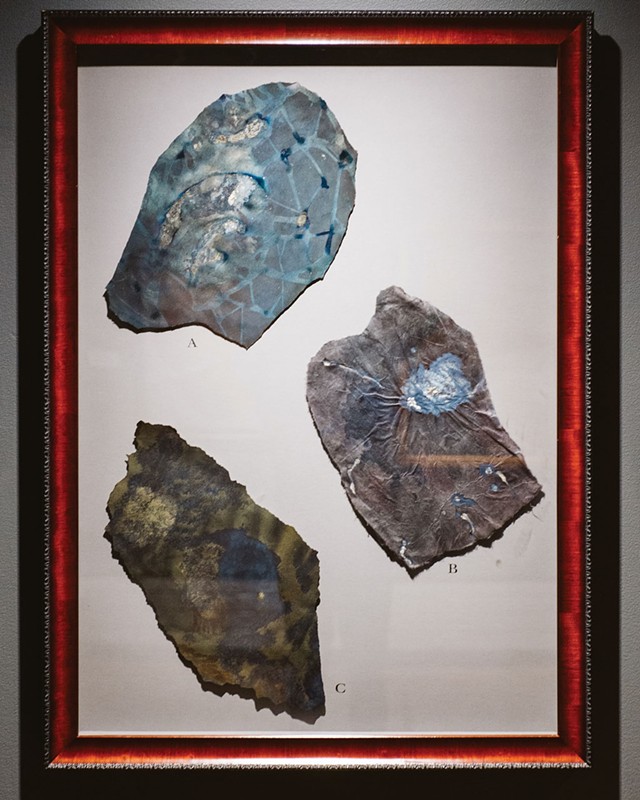
- Courtesy Of Sam Simon
- Details from "Falling Into Language: A Travelogue" installation
Back in Vermont, where TwoTrees has lived full time since 2012, she found two singers to do just that: Heidi Ann Wilson and Gideon Crevoshay. Both are workshop leaders with Village Harmony, the Marshfield-based choral project. Wilson had collaborated with TwoTrees on the latter's 2015 "Of Land and Local" installation at Shelburne Farms, titled "Natives, Slaves, Settlers and Visitors — Seen and Unseen." Crevoshay has sung around the world and recently became a member of Meredith Monk's House Foundation for the Arts.
The exhibition soundtrack has multiple iterations, TwoTrees said. The current one features Wilson and Crevoshay. In mid-July, it will be replaced by a track featuring two musicians whom the artist met in India: Yuji Nakagawa, a sarangi player born in Japan; and singer Shruthi Veena Vishwanath. A third soundtrack, to be installed in the fall, will emerge from two virtual workshops about vocables that TwoTrees is offering to the public.
BCA curator Heather Ferrell discovered TwoTrees when the artist invited her for a studio visit as she created "Falling Into Language." Much about the project appealed to the curator.
"It was fascinating how it was all coming together: the international collaboration, the sophistication of exploring language nonverbally, [the idea of] a universal subconscious," Ferrell recalled in a phone call. "That's a very intangible thing to capture in a work of art, but I think the show does it beautifully.
"Also, the idea that you do all these paintings and then rip them up," she added. "They're not precious. They're more than just paintings."
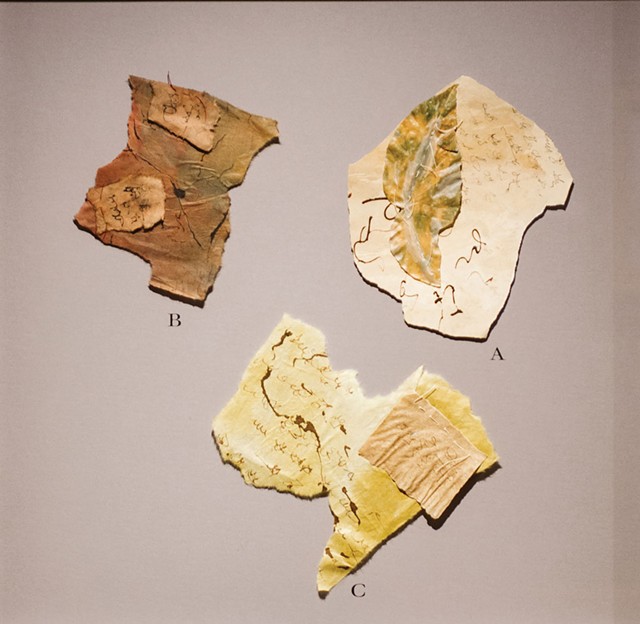
- Courtesy Of Sam Simon
- Details from "Falling Into Language: A Travelogue" installation
Ferrell selected TwoTrees to receive financial help from BCA to complete her project. The artist also won a development grant and a creation grant from the Vermont Arts Council.
As Ferrell pointed out, TwoTrees' identity tends to be central to her work.
Describing "Natives, Slaves, Settlers and Visitors — Seen and Unseen," TwoTrees said the installation explored the different groups of Vermonters listed in her title through their spoken stories, whether they were victims of eugenics, Black farmers in Hinesburg or Abenaki telling their people's creation story. Each section also integrated images of her own ancestors. "I was trying to figure out how I fit here," the artist said.
"Falling Into Language," by contrast, attempts to get beyond current identity politics, which TwoTrees finds limiting.
"I've spent a lifetime doing diversity and equity work from the perspective of standing at the crossroads of these identities, but [now] the naming and claiming of identity feels like things are getting very tight," she said.
"Falling Into Language" is intended to allow visitors to "fall into sensing rather than meaning making," TwoTrees said. "Hopefully that will invoke, evoke, maybe even provoke a memory — a feeling — of something bigger and more expansive than the borders we put around ourselves.
"It's the journey that my Native elders took," the artist added. "They always talked about what we can know when we open ourselves up to something bigger than ourselves."
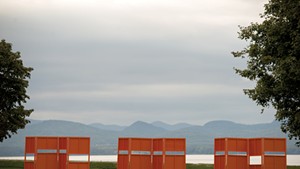









Comments
Comments are closed.
From 2014-2020, Seven Days allowed readers to comment on all stories posted on our website. While we've appreciated the suggestions and insights, right now Seven Days is prioritizing our core mission — producing high-quality, responsible local journalism — over moderating online debates between readers.
To criticize, correct or praise our reporting, please send us a letter to the editor or send us a tip. We’ll check it out and report the results.
Online comments may return when we have better tech tools for managing them. Thanks for reading.